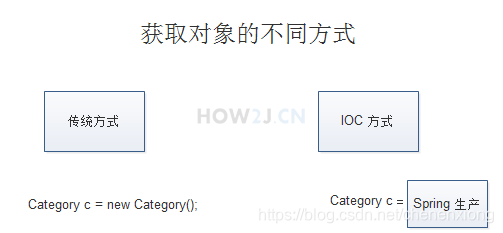一、Spring IOC/DI (控制反转/依赖注入)
1、创建pojo模型,提供set/get方法
public class Category {
private int id;
private String name;
}
2、src目录下创建applicationContext.xml是Spring的核心配置文件
该对象获取的时候,即被注入了字符串"category 1“到name属性中
<?xml version="1.0" encoding="UTF-8"?>
<beans xmlns="http://www.springframework.org/schema/beans"
xmlns:xsi="http://www.w3.org/2001/XMLSchema-instance"
xmlns:aop="http://www.springframework.org/schema/aop"
xmlns:tx="http://www.springframework.org/schema/tx"
xmlns:context="http://www.springframework.org/schema/context"
xsi:schemaLocation="
http://www.springframework.org/schema/beans
http://www.springframework.org/schema/beans/spring-beans-3.0.xsd
http://www.springframework.org/schema/aop
http://www.springframework.org/schema/aop/spring-aop-3.0.xsd
http://www.springframework.org/schema/tx
http://www.springframework.org/schema/tx/spring-tx-3.0.xsd
http://www.springframework.org/schema/context
http://www.springframework.org/schema/context/spring-context-3.0.xsd">
<bean name="c" class="com.how2java.pojo.Category">
<property name="name" value="category 1" />
</bean>
</beans>
3、编写测试代码
public class TestSpring {
public static void main(String[] args){
ApplicationContext context = new ClassPathXmlApplicationContext(new String[]{"applicationContext.xml"});
Category category = (Category) context.getBean("category");
System.out.println(category.getName());
}
}
4、原理图
以获取对象的方式来进行比较
传统的方式:
通过new 关键字主动创建一个对象
IOC方式
对象的生命周期由Spring来管理,直接从Spring那里去获取一个对象。 IOC是反转控制 (Inversion Of Control)的缩写,就像控制权从本来在自己手里,交给了Spring。
打个比喻:
传统方式:相当于你自己去菜市场new 了一只鸡,不过是生鸡,要自己拔毛,去内脏,再上花椒,酱油,烤制,经过各种工序之后,才可以食用。
用 IOC:相当于去馆子(Spring)点了一只鸡,交到你手上的时候,已经五味俱全,你就只管吃就行了。

二、注入对象
1、Product中创建属性Category
2、applicationContext.xml中添加配置
<bean name="c" class="com.cex.pojo.Category">
<property name="name" value="category 1" />
</bean>
<bean name="p" class="com.cex.pojo.Product">
<property name="name" value="product1" />
<property name="category" ref="c" />
</bean><bean name="c" class="com.cex.pojo.Category">
<property name="name" value="category 1" />
</bean>
<bean name="p" class="com.cex.pojo.Product">
<property name="name" value="product1" />
<property name="category" ref="c" />
</bean>
3、创建测试类
public class TestSpring {
public static void main(String[] args){
ApplicationContext context = new ClassPathXmlApplicationContext(new String[]{"applicationContext.xml"});
Product product = (Product) context.getBean("product");
System.out.println(product.getCategory().getName());
}
}
三、注解方式IOC/DI
1、applicationContext.xml中添加配置,表示告诉Spring要用注解的方式
<context:annotation-config/>
2、Product的Category属性上添加注解
@Autowired by type
@Resource by name
@Autowired
private Category category;
3、对Bean的注解
applicationContext.xml配置
<?xml version="1.0" encoding="UTF-8"?>
<beans xmlns="http://www.springframework.org/schema/beans"
xmlns:xsi="http://www.w3.org/2001/XMLSchema-instance"
xmlns:aop="http://www.springframework.org/schema/aop"
xmlns:tx="http://www.springframework.org/schema/tx"
xmlns:context="http://www.springframework.org/schema/context"
xsi:schemaLocation="
http://www.springframework.org/schema/beans
http://www.springframework.org/schema/beans/spring-beans-3.0.xsd
http://www.springframework.org/schema/aop
http://www.springframework.org/schema/aop/spring-aop-3.0.xsd
http://www.springframework.org/schema/tx
http://www.springframework.org/schema/tx/spring-tx-3.0.xsd
http://www.springframework.org/schema/context
http://www.springframework.org/schema/context/spring-context-3.0.xsd">
<context:annotation-config/>
<context:component-scan base-package="com.cex.pojo"/>
</beans>
4、模型上增加注解
@Component("c")
public class Category
四、AOP面向切面编程
1、创建一个业务类
public class ProductService {
public void doSomeService(){
System.out.println("doSomeService");
}
}
2、准备日志切面 LoggerAspect
public class LoggerAspect {
public Object log(ProceedingJoinPoint joinPoint){
System.out.println("start log "+joinPoint.getSignature().getName() );
Object object = joinPoint.proceed();
System.out.println("start log "+joinPoint.getSignature().getName() );
return object;
}
}
3、配置applicationContext.xml
<?xml version="1.0" encoding="UTF-8"?>
<beans xmlns="http://www.springframework.org/schema/beans"
xmlns:xsi="http://www.w3.org/2001/XMLSchema-instance"
xmlns:aop="http://www.springframework.org/schema/aop"
xmlns:tx="http://www.springframework.org/schema/tx"
xmlns:context="http://www.springframework.org/schema/context"
xsi:schemaLocation="
http://www.springframework.org/schema/beans
http://www.springframework.org/schema/beans/spring-beans-3.0.xsd
http://www.springframework.org/schema/aop
http://www.springframework.org/schema/aop/spring-aop-3.0.xsd
http://www.springframework.org/schema/tx
http://www.springframework.org/schema/tx/spring-tx-3.0.xsd
http://www.springframework.org/schema/context
http://www.springframework.org/schema/context/spring-context-3.0.xsd">
<context:annotation-config/>
<context:component-scan base-package="com.cex.pojo"/>
<!-- <bean name="category" class="com.cex.pojo.Category">
<property name="name" value="category 1" />
</bean>
<bean name="product" class="com.cex.pojo.Product">
<property name="name" value="product 1"/>
<property name="category" ref="category" />
</bean>-->
<bean name="service" class="com.cex.service.ProductService"/>
<bean id="loggerAspect" class="com.cex.aspect.LoggerAspect"/>
<aop:config>
<aop:pointcut id="loggerCutPoint" expression="execution(* com.cex.service.ProductService.*(..))"/>
<!--第一个*表示返回任意类型,第二个类型表示任意方法-->
<aop:aspect id="logAspect" ref="loggerAspect">
<aop:around method="log" pointcut-ref="loggerCutPoint"/>
</aop:aspect>
</aop:config>
</beans>
4、测试类
public class TestSpring {
public static void main(String[] args){
ApplicationContext context = new ClassPathXmlApplicationContext(new String[]{"applicationContext.xml"});
Product product = (Product) context.getBean("p");
System.out.println(product.getCategory().getName());
ProductService service = (ProductService)context.getBean("service");
service.doSomeService();
}
}
五、注解方式AOP
1、注解配置业务类
package com.cex.service;
import org.springframework.stereotype.Component;
@Component("s")
public class ProductService {
public void doSomeService(){
System.out.println("doSomeService");
}
}
2、注解配置切面
@Aspect
@Component
public class LoggerAspect {
@Around(value = "execution(* com.cex.service.ProductService.*(..))")
public Object log(ProceedingJoinPoint joinPoint) throws Throwable {
System.out.println("start log "+joinPoint.getSignature().getName() );
Object object = joinPoint.proceed();
System.out.println("start log "+joinPoint.getSignature().getName() );
return object;
}
}
3、applicationContext.xml中增加配置
<context:annotation-config/>
<context:component-scan base-package="com.cex.pojo"/>
<context:component-scan base-package="com.cex.aspect"/>
<context:component-scan base-package="com.cex.service"/>
六、注解方式测试
测试类中进行如下配置:
@RunWith(SpringJUnit4ClassRunner.class)
@ContextConfiguration("classpath:applicationContext.xml")
public class TestSpring {
@Autowired
Category category;
@Test
public void test(){
System.out.println(category.getName());
}








 本文深入讲解Spring框架的IOC/DI、AOP等核心概念,包括控制反转、依赖注入的实现方式,以及面向切面编程的注解配置和使用示例。
本文深入讲解Spring框架的IOC/DI、AOP等核心概念,包括控制反转、依赖注入的实现方式,以及面向切面编程的注解配置和使用示例。
















 4万+
4万+

 被折叠的 条评论
为什么被折叠?
被折叠的 条评论
为什么被折叠?








